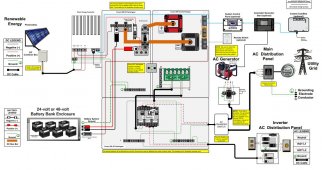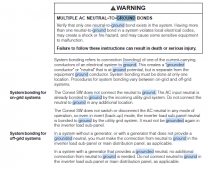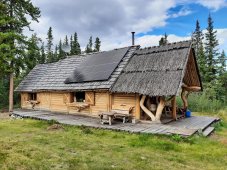Hi there,
I am in the process of installing an off-grid solar system using Schneider electric products. I am basically following the schematic provided by Schneider (see attached) with no tie to the grid as I am completely off-grid.
My system in a nutshell: 3000W solar array + 20KW battery bank (48V) + 4000W inverter/charger.
I have installed the solar panels and I am getting ready to install the rest of the equipment. The previous owner had a generator tied to the house and I am planning to reuse it to recharge my battery bank when sunlight is scarce. The generator is a Honda EM5000SX and is located roughly 100m away from the house. The generator is tied to a grounding rod.
My questions:
1/ After reading forums and documentation of my charge controller (Schneider MMPT 60 150), it looks like it does provide a "negative ground bond for negative grounded PV array systems". Does this mean that I should only make sure there is no bonding at the generator?
2/ Is it safe to use that grounding rod for my system as is or is it too far from the rest of the equipment (100m)?
I will post a schematic of my installation tomorrow to better illustrate my plans.
Thank you for your help
I am in the process of installing an off-grid solar system using Schneider electric products. I am basically following the schematic provided by Schneider (see attached) with no tie to the grid as I am completely off-grid.
My system in a nutshell: 3000W solar array + 20KW battery bank (48V) + 4000W inverter/charger.
I have installed the solar panels and I am getting ready to install the rest of the equipment. The previous owner had a generator tied to the house and I am planning to reuse it to recharge my battery bank when sunlight is scarce. The generator is a Honda EM5000SX and is located roughly 100m away from the house. The generator is tied to a grounding rod.
My questions:
1/ After reading forums and documentation of my charge controller (Schneider MMPT 60 150), it looks like it does provide a "negative ground bond for negative grounded PV array systems". Does this mean that I should only make sure there is no bonding at the generator?
2/ Is it safe to use that grounding rod for my system as is or is it too far from the rest of the equipment (100m)?
I will post a schematic of my installation tomorrow to better illustrate my plans.
Thank you for your help






